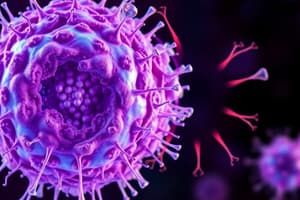Podcast
Questions and Answers
Which characteristic is unique to prokaryotic cells compared to eukaryotic cells?
Which characteristic is unique to prokaryotic cells compared to eukaryotic cells?
- Have a single, closed circular loop of DNA (correct)
- Possess a membrane-bound nucleus
- Have a cytoskeleton for structure
- Contain membrane-bound organelles
What role do chloroplasts play in plant cells?
What role do chloroplasts play in plant cells?
- They synthesize proteins
- They provide structural support
- They convert light energy into glucose (correct)
- They aid in cellular respiration
What is a common function of the organelles found in eukaryotic cells?
What is a common function of the organelles found in eukaryotic cells?
- Transporting materials across the membrane
- Maintaining rigid structure
- Cell movement
- Energy production (correct)
Which of the following statements about animal cells is accurate?
Which of the following statements about animal cells is accurate?
What structural feature is present in eukaryotic cells but not in prokaryotic cells?
What structural feature is present in eukaryotic cells but not in prokaryotic cells?
What is the primary structural component of eukaryotic cells?
What is the primary structural component of eukaryotic cells?
Which of the following statements accurately describes prokaryotic cells?
Which of the following statements accurately describes prokaryotic cells?
Why is cellular diversity crucial in complex organisms?
Why is cellular diversity crucial in complex organisms?
Which distinguishing feature of eukaryotic cells is absent in prokaryotic cells?
Which distinguishing feature of eukaryotic cells is absent in prokaryotic cells?
In what way do prokaryotic cells differ in size compared to eukaryotic cells?
In what way do prokaryotic cells differ in size compared to eukaryotic cells?
Flashcards are hidden until you start studying
Study Notes
Introduction to Eukaryotic Cells
- The cell is the fundamental unit of structure and function in living organisms.
- Human bodies consist of trillions of specialized cells vital for diverse functions.
- Water constitutes about two-thirds of a cell, with proteins, lipids, and carbohydrates making up the remainder.
- Cells transform raw materials from food into necessary molecules through various metabolic processes.
Prokaryotic Cells
- Comprised of bacteria and archaea, typically measuring 0.1–5 μm in diameter.
- DNA exists as a circular strand in the nucleoid region, without a membrane-bound nucleus.
- Structure includes:
- Rigid outer cell wall and lipid cell membrane
- Pili and flagella for movement
- Transport proteins for material exchange
- Fluid-like cytoplasm with free-floating ribosomes and plasmid DNA
Eukaryotic Cells
- Found in plants, animals, fungi, and protists, ranging from 10–100 μm in diameter.
- DNA is enclosed within a membrane-bound nucleus.
- Characterized by:
- Some possessing a rigid cell wall (e.g., plant cells)
- Inner lipid cell membrane and cytoplasm containing a cytoskeleton for structure
- Organelles (e.g., mitochondria, chloroplasts, endoplasmic reticulum, lysosomes, Golgi body) performing specialized functions
Comparison of Plant and Animal Cells
- Plant cells perform photosynthesis to produce glucose, utilizing chloroplasts.
- Animal cells use glucose to carry out cellular respiration.
- Plant cells have a supportive cell wall, which is absent in animal cells.
- Both cell types utilize a cytoskeleton and plasma membrane but differ in vesicle sizes for waste and material transport.
Similarities Between Prokaryotic and Eukaryotic Cells
- Both types are cellular structures containing DNA as genetic material.
- Common features include the presence of cytoplasm and the ability to reproduce.
- Both transcribe DNA into RNA and translate RNA into proteins on ribosomes.
- Regulate cellular transport and require chemical energy for metabolic processes.
Key Differences
- Prokaryotic cells lack a membrane-bound nucleus, while eukaryotic cells do contain one.
- Prokaryotic cells have simpler structures without organelles compared to the highly organized eukaryotic cells with multiple specialized organelles.
- Size differences: prokaryotic cells are generally much smaller than eukaryotic cells.
Summary
- Understanding the distinctions and similarities between prokaryotic and eukaryotic cells is essential in cell biology.
- Recognizing the unique characteristics of each cell type contributes to the comprehension of complexity in life forms.
Studying That Suits You
Use AI to generate personalized quizzes and flashcards to suit your learning preferences.




